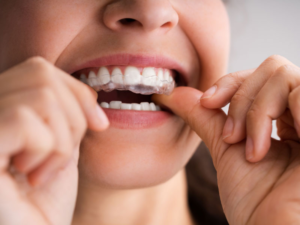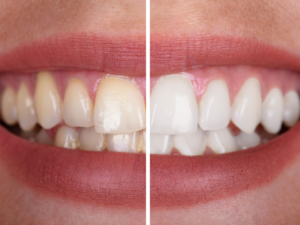
Periodontal disease – also known as periodontitis or simply gum disease – infects gum tissues and bone structures that support teeth. It’s a common problem among adults in the U.S., and the main cause of tooth loss. According to the National Institute of Dental and Craniofacial Research (NIDCR), 40 percent of adults have some form of periodontal disease. The first stage of periodontitis is gingivitis. Without treatment, this can progress to advanced periodontal disease and trigger other serious health issues.
What Causes Periodontal Disease?
Periodontal disease develops after plaque builds up on and around teeth. This sticky biofilm contains millions of bacteria. As these microbes feed on sugars in the foods we eat, they produce organic acids that cause infection as they attack oral tissues. This prompts a response from the immune system that results in gum inflammation as the body tries to fight the bacterial onslaught.
Periodontal Disease Risk Factors
Poor oral hygiene is the chief cause of periodontal disease, particularly as we get older. Other factors can increase the risk of gum disease or make the condition worse once infection has set in. These include:
- Medical conditions including diabetes, leukemia and cardiovascular problems.
- Medications that cause dry mouth (xerostomia). Without an adequate supply of saliva, plaque is more likely to build up.
- Genetics. Research indicates 30 percent of the population may have a genetic susceptibility to periodontal disease.
- Smoking – one of the most serious risk factors in developing gum disease, and the leading cause of periodontal disease that resists treatment.
- Orthodontic problems. Misaligned or crowded teeth are more difficult to clean, which increases the risk of plaque build-up.
Symptoms of Periodontal Gum Disease
Periodontal disease often develops and progresses without pain or other noticeable warning signs. In cases where symptoms are apparent, they may include:
- Bleeding gums
- Swollen gums
- Red gums
- Soft gums
- Gum recession, exposing more tooth structure
- Tooth sensitivity to hot or cold foods and drinks
- Loose teeth
- Persistent bad breath
- Bad taste in the mouth
- Change in bite function
- Pus between the teeth and gums
- Mouth sores
How is Periodontal Disease Diagnosed?
Development and progression of periodontal disease can only be determined by a dentist. This is one reason regular dental exams are imperative. Detection of early stages of gum disease enable the most effective treatment.
Diagnosing periodontal disease involves:
- Checking teeth alignment.
- Measuring the depth of spaces between your teeth and gums – periodontal pockets.
- Evaluating jawbone condition.
All adults should get a comprehensive periodontal evaluation (CPE) every year, according to the American Academy of Periodontology (AAP).
How is Periodontal Disease Treated?
Mild cases of periodontal disease may respond to better oral hygiene, supported by regular dental checkups and professional cleanings. Other cases can be treated with non-surgical options. Advanced gum disease may require surgery.
Non-Surgical Periodontal Treatment
The main non-surgical treatment for gum disease is scaling and root planing. This procedure removes plaque and tartar (calcified plaque) from beneath the gum line. Scaling is done with metal scraping instruments or ultrasonic technology, or a combination of both. Root planing entails smoothing the root surface of teeth to eradicate bacteria and the toxins they produce. Your dentist may also prescribe anti-inflammatory medication. This can be in tablet form or applied directly to the gums. An antibacterial, fluoride toothpaste may also be beneficial.
Surgical Periodontal Treatment
If bone and soft tissues anchoring your teeth have been destroyed by periodontal disease, several surgical options are available, including:
- Osseous surgery (also called pocket reduction surgery) to eliminate bacteria.
- Laser gum surgery to kill bacteria and promote bone growth.
- Guided tissue regeneration to restore bone tissue.
- Soft-tissue graft.
- Bone graft.
Importance of Oral Hygiene in Preventing Periodontal Disease
Good oral hygiene is key for strong and healthy gums resilient to periodontitis.
- Brush your teeth, gum line, and tongue every morning and night. An electric toothbrush removes plaque and tartar more effectively.
- Use a toothbrush with soft bristles. This avoids damaging the gums.
- Use an antibacterial, fluoride toothpaste to kill oral germs and strengthen your teeth.
- Angle the brush head at 45 degrees toward the gum.
- After brushing, rinse the brush and let it dry naturally. This minimizes the risk of bacterial growth.
- Floss between your teeth at least once a day.
- Use an antibacterial, fluoride mouthwash.
- Drink plenty of water to flush away oral bacteria.
Dental Checkups and Cleanings
Besides oral health care at home, you also need a little professional help to minimize the risk of gum disease or detect the condition in its early stages, when it’s easier to manage.
- Regular dental exams. These appointments enable your dentist to diagnose early signs of gum disease, such as plaque and tartar accumulation and periodontal pockets.
- Professional cleanings. Dental checkups typically incorporate a professional cleaning. This eliminates bacteria and plaque that can build up even if you brush and floss regularly. Tartar can only be removed by a dental professional using special instruments.
Lifestyle Changes That Help Prevent Gum Disease
In addition to a solid routine of oral health care, in some cases lifestyle changes can help keep periodontal disease at bay. Here are some things you may need to do.
- Maintain a nutritional, gum-friendly diet balanced with a combination of fruit, vegetables, meat, fish, and whole-grain and dairy products. A poor diet weakens your immune system, making it more difficult to fight off gum infection.
- Avoid or limit sugary drinks and foods. These attract the bacteria that cause gum disease.
- Quit smoking. Smokers are particularly susceptible to gum infection, and smoking makes it harder for inflamed gums to heal.
- Maintain a healthy weight. Obesity has been linked with gum problems.
Periodontal Care at Your Irving Dentist
Irving dentist Dental Concepts & Orthodontics offers several non-surgical and surgical options for periodontal disease treatment. We also provide comprehensive follow-up care in the form of periodontal maintenance to monitor and optimize oral health – crucial to ensure gums remain free from infection.
Periodontal maintenance includes periodic removal of bacteria-laden plaque and tartar from above and below the gum line. These deep cleanings keep levels of bacteria under control before they can do more damage. Periodontal aftercare also benefits your general dental health by preventing reinfection that can spread from your mouth via the bloodstream to other areas of the body, including vital organs.
If you suspect you have gum problems, schedule a periodontal consultation with us now. Contact our Irving dental office. Contact our Allen office.n a tooth.







